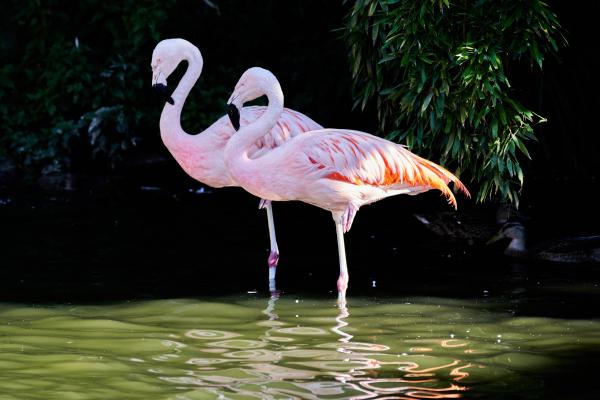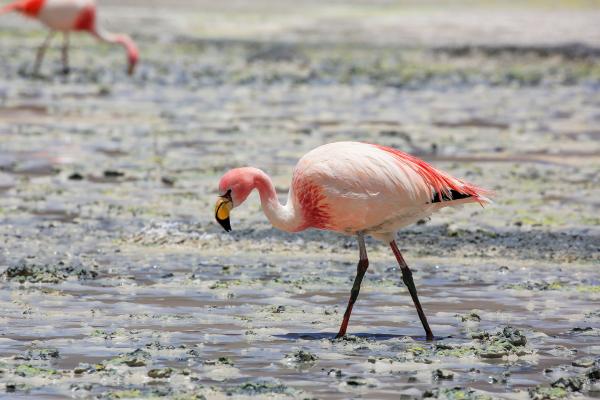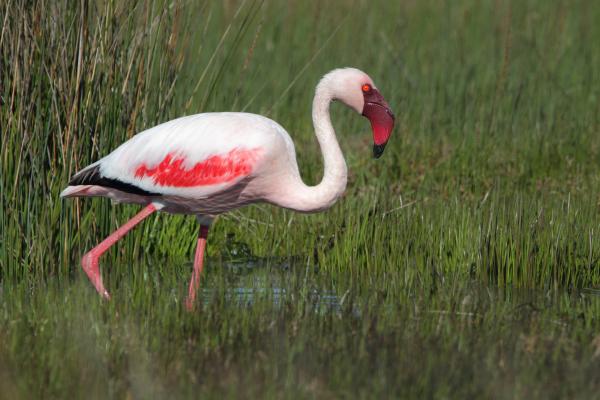Flamingos are distinctive long-legged birds famous for their vibrant pink plumage, which results from carotenoid pigments found in their diet of plants and algae. These birds inhabit saline or alkaline waters and are highly social, often gathering in striking large flocks. While commonly called “flamingos” in English, the correct term in many languages translates to “fire birds” or “flamingos.”

Currently, there are six main species of flamingos divided into the larger genus Phoenicopterus and the smaller genus Phoenicoparrus (known as “parinas”). Here is an overview of these six flamingo species, their characteristics, habitats, and conservation status.
Caribbean Flamingo (Phoenicopterus ruber)
Native to the tropical Americas, including Mexico’s Yucatán, Florida, Galápagos Islands, northern Venezuela, and Colombia. Measuring 1.2 to 1.4 meters, it is the largest flamingo in the Americas, with intense pink to nearly red plumage. Its curved bill filters algae, crustaceans, and insects.

Chilean Flamingo (Phoenicopterus chilensis)
Distributed widely across South America, from Peru to Chile and Argentina. Size ranges from 1 to 1.3 meters. Features gray legs with pink knees, mostly black bill, and pale pink feathers.

Andean Greater Flamingo or Parina (Phoenicoparrus andinus)
Found in the Andes mountains, notable for yellow legs and about 1 meter in length. The tail has black feathers, while the neck and chest are pink. It is the largest flamingo species in the Andes.

James’s Flamingo or Lesser Parina (Phoenicoparrus jamesi)
Also native to the Andes, this is the smallest species. It has a less curved orange bill with a typical black tip, reddish neck and back, and a smaller amount of black tail feathers.

Greater Flamingo (Phoenicopterus roseus)
The most widespread flamingo species, found across southern and central Asia, Africa, and southern Europe. Length ranges from 1.1 to 1.5 meters. It has a particularly long neck that forms a pronounced U-shape when feeding, bright red wing feathers, and pale pink body plumage.

Lesser Flamingo (Phoenicopterus minor)
The smallest flamingo, standing 80 cm to 1 meter tall. It inhabits southern Asia and Africa and occasionally appears in Spain. Found in alkaline Rift Valley lakes feeding mainly on spirulina algae. Its bill is entirely dark with a reddish tip, and plumage ranges from pale pink to whitish.

Chilean Flamingo: Near threatened due to egg collection and water diversion projects reducing populations.
James’s Flamingo: Near threatened due to climate change impacting diatom food supply, plus egg collection and tourism pressures.
Andean Greater Flamingo: Vulnerable with declining populations caused by egg poaching, habitat erosion, water depletion, and mining.
Lesser Flamingo: Near threatened, with only three breeding sites remaining affected by hydroelectric projects and mining, plus water pollution.
Explore more in our Fox Species and Seagull Species articles.
animal tags: Flamingos
We created this article in conjunction with AI technology, then made sure it was fact-checked and edited by a Animals Top editor.